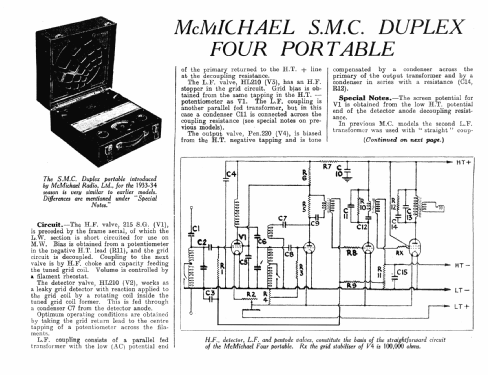Duplex four SMC early
McMichael Radio Ltd.; Slough
- Produttore / Marca
- McMichael Radio Ltd.; Slough
- Anno
- 1933/1934
- Categoria
- Radio (o sintonizzatore del dopoguerra WW2)
- Radiomuseum.org ID
- 178620
-
- alternative name: McMichael, Leslie
Clicca sulla miniatura dello schema per richiederlo come documento gratuito.
- Numero di tubi
- 4
- Principio generale
- A reazione (con rigenerazione); 2 Stadi BF
- N. di circuiti accordati
- 2 Circuiti Mod. Amp. (AM)
- Gamme d'onda
- Onde medie (OM) e onde lunghe (OL).
- Tensioni di funzionamento
- Batterie (di accumulatori e/o a secco) / 2 & 126 Volt
- Altoparlante
- AP magnetodinamico (magnete permanente e bobina mobile) / Ø 5 inch = 12.7 cm
- Potenza d'uscita
- 0.3 W (qualità ignota)
- Materiali
- Pelle / stoffa / plastica ma con altro materiale sottostante
- Radiomuseum.org
- Modello: Duplex four SMC [early] - McMichael Radio Ltd.; Slough
- Forma
- Apparecchio portatile > 20 cm (senza la necessità di una rete)
- Dimensioni (LxAxP)
- 390 x 220 x 380 mm / 15.4 x 8.7 x 15 inch
- Annotazioni
- The early model SMC has a manual volume control by means of a variable filament current for the RF stage, while the late model used to vary the RF stage grid bias.
This is a leathercovered suitcase model. The lid of the case contains the frame aerial and the loudspeaker.
- Peso netto
- 13 kg / 28 lb 10.1 oz (28.634 lb)
- Bibliografia
- Radio! Radio! (p.127, fig.368)
- Letteratura / Schemi (1)
- Hardware analysis.
- Autore
- Modello inviato da Konrad Birkner † 12.08.2014. Utilizzare "Proponi modifica" per inviare ulteriori dati.
- Altri modelli
-
In questo link sono elencati 183 modelli, di cui 123 con immagini e 120 con schemi.
Elenco delle radio e altri apparecchi della McMichael Radio Ltd.; Slough
Discussioni nel forum su questo modello: McMichael Radio Ltd.: Duplex four SMC
Argomenti: 1 | Articoli: 1
There is an early version applying manual gain control by means of filament variation in the RF stage.
This was state of the art for battery triodes in the late 1920's.
But now the RF triode was replaced by a superior screen grid valve. Such a valve is behaving different to filament variations, in particular at low emission for low gain, where the setting is rather unstable.
Obviously led this drawback to a redesign of the volume control by leaving the filament on full supply while a variable grid bias was introduced. This results in an easier and smoother control function.
The available documentation describes the late version only.
The early version was on my workbench for repair. It had a low resistance rheostat (original, physically identical with the high resistance potentiometer in the late version) but some "repair" attempts of previous owners left a chaos: senseless resoldered wires, wrongly connected on-off-switch etc.
He must have desperately decided to sell the spoiled thing after replacing two original Audios by defect ones (different brands; all 4 windings open), putting four valves with open filament. The next owner (in Germany) could not do much better and sold it again.
Now the buyer asked me for help.
I can proudly report that the radio is back to life now (after spending about 3 days to navigate through the wiring jungle and the wrong map (schematic)...
Konrad Birkner † 12.08.2014, 20.Jul.10

